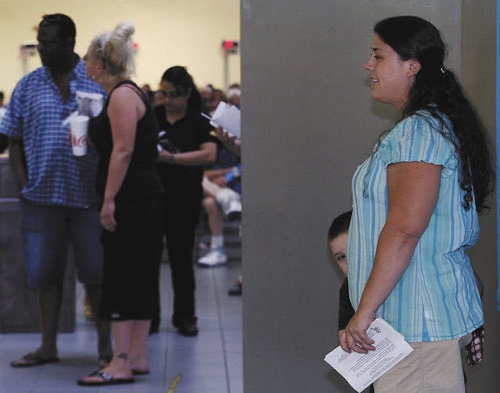Indicators say people still moving to Las Vegas Valley

Las Vegas isn’t slouching toward ghost-town status just yet.
Despite an unemployment rate of 13.8 percent and an epic housing bust with nation-leading foreclosure rates, a couple of recent indicators hint that people continue to move to Southern Nevada.
The question, experts say, is whether the number of people leaving outpaces in-migration. The jury’s also out on whether the newest statistics are anomalies or long-term trends.
“We’re trying to figure out these numbers because they don’t make a whole lot of sense,” said Jeremy Aguero, a principal in local research and consulting firm Applied Analysis. “Common sense would tell you, with the economy the way it is, that people would not be moving in.”
Or maybe they are.
The number of out-of-state driver’s licenses surrendered in Clark County surged in the first half of 2011, to 28,664 turn-ins, according to the state Department of Motor Vehicles. That’s up 21.7 percent when compared with 23,554 surrenders in the first six months of 2010. Top states for surrenders include California, Arizona, Florida, Texas and Utah.
There are some caveats. State law gives new residents 30 days to trade in an old license for a Nevada version, but plenty of motorists wait way longer, said Kevin Malone, public information officer for the department. Some new licensees might have lived here for months or even years. Plus, there’s no offsetting figure to indicate how many Nevadans surrendered their Silver State licenses in other states, state demographer Jeff Hardcastle said.
But customer numbers from NV Energy do take into account the recently departed, and those numbers are up, slightly. The local power utility has added roughly 1 percent to its customer base, as measured by activated meters, for each of the past three quarters.
NV Energy can’t tell whether its new customers came from out of state or simply moved from somewhere else in Clark County, however. And new homes count in the total, even if unoccupied. Still, the utility knows it has more customers now than it did nine months ago.
Hardcastle uses new meter connections in his population studies, but he said it’s too soon to say whether those three quarters represent permanent growth.
“There’s a little bit of positive information out there about people flowing in, but until our job situation really turns around, I’m not sure if it’s a long-term trend,” he said. “We have not had the sustained job growth that would really drive people moving here.”
But many newcomers might not be in need of work, Aguero said. Realtors tell him they’re fielding lots of out-of-state calls from retirees and people nearing retirement.
And there’s tantalizing evidence that leaving Las Vegas isn’t as popular as it once was.
Start with an Applied Analysis survey asking locals whether they’ve considered or are planning to leave the city. During the boom era, before 2007, 19 percent said yes. A year ago, at the recession’s nadir, that number had fallen to 14 percent. Some respondents said they couldn’t leave because they were tied to their home, while others said they had moved parents and children here, had become settled and were determined to stick it out. Still others said they couldn’t move because they simply had no better place to go.
Another tell-tale sign of stability: Clark County School District enrollments have stayed flat during the recession.
Meanwhile, U-Haul reports that it helped 1.3 percent more people leave Las Vegas than move here between January 2010 and June , not a significant imbalance over 18 months.
Why stay in a town that has seen better days?
For one thing, if you exclude construction and government, employment in Las Vegas has grown by 18,600 positions, nearly 3 percent, since bottoming out in August 2009, including 7,300 new jobs year over year in June. Industries including leisure and hospitality, education, health services and professional services have all added jobs in recent months. That job growth could be encouraging some residents to stay, Aguero said.
Hardcastle said he will have a better handle on population trends when the Internal Revenue Service releases its county-to-county migration numbers for 2009 to 2010. Also, data showing state-by-state Medicare enrollment could soon shed light on retiree relocations. He’s not sure when federal agencies will report the figures, but he doesn’t expect them to show anything dramatic.
“I think, at best, things are flat for the moment,” he said.
Still, even steady numbers could be a good sign for a state that has held much of its population while leading a nationwide economic bust.
“It does portend that many of the things that were attractive about Las Vegas are still attractive to people,” Aguero said. “The low cost of housing; weather in which you don’t have to shovel snow; no personal income tax — those types of things continue to appeal to folks. Las Vegas is a lower-cost alternative and a value-based location for retirement. Let’s not forget how big the Baby Boomer population is, and how many people turn 65 in this country every day.”
Contact reporter Jennifer Robison at jrobison@reviewjournal.com or 702-380-4512.